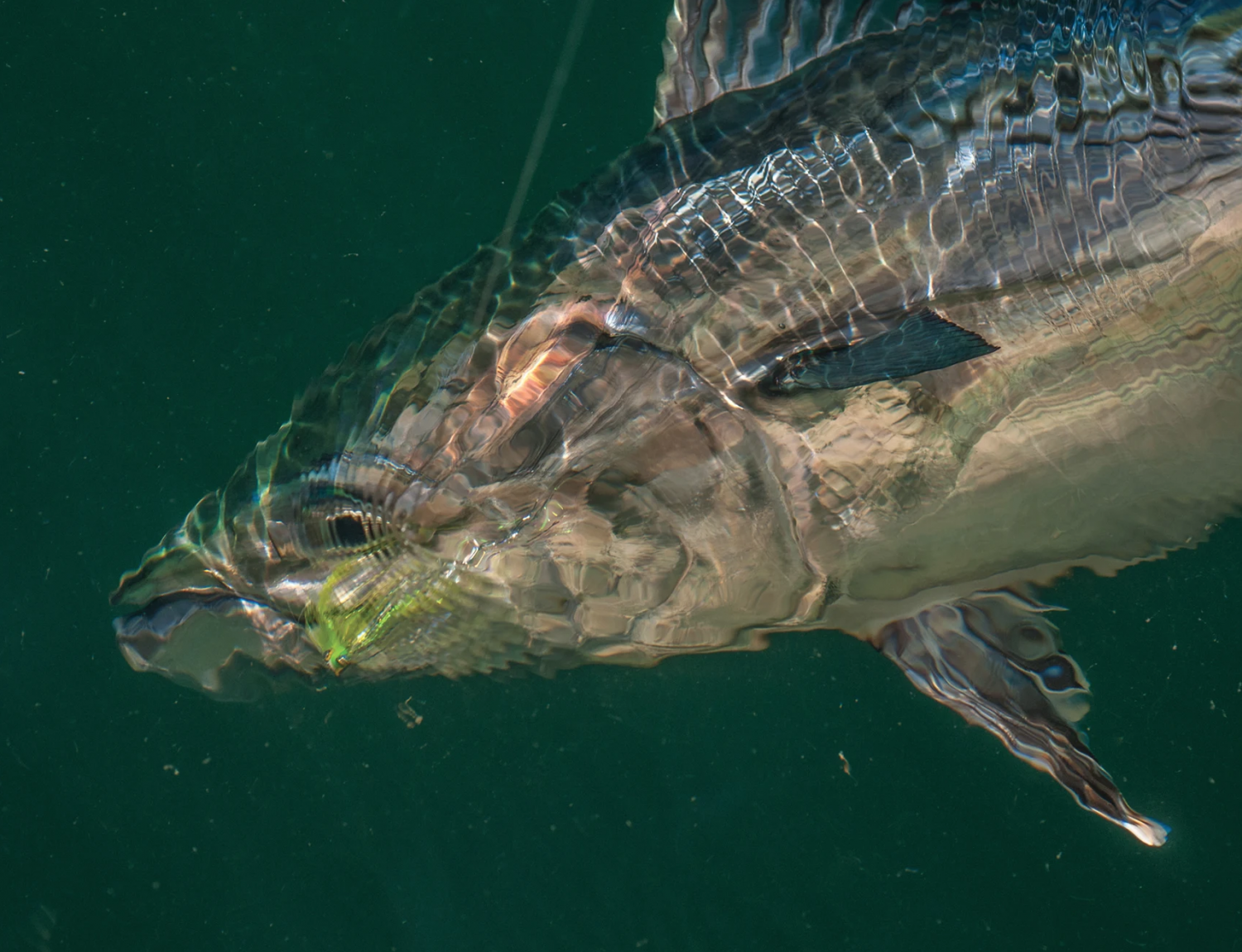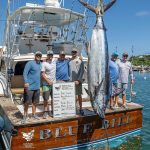Article Courtesy: anglersjournal.com | Updated: 10/19/20 | Photo Credit: Brian Horsley | Click here for original article
Crazy Good
Fall action peaks for light-tackle addicts when schools of quicksilver albies crash the seasonal party
It’s a raw, cold October morning off North Carolina’s Barden Inlet. A shrimp trawler steams south with about 10,000 seabirds in tow. A layer of thick, gray clouds hangs low in the sky. A bone-chilling westerly stirs up steep, foam-capped waves.
Anyone with even a smidgen of common sense is still in bed.
Not us.
High on the afterglow of the previous day’s false albacore fishing, my friends Hugh, Kendall and I want to get in a few hours of fishing before the real blow fills in. Hugh weaves us through the confused inlet chop while Kendall and I hold shut the hoods on our foulies.
We’re making about 20 knots through the slop when we discover other crazies. At least 15 other boats line up behind the trawler like it’s a Chick-fil-A drive-through. Mates pitch bycatch overboard. Dozens of sharks and false albacore slice through the trawler’s prop wash.
“Pitch it!” Hugh yells as I back-cast a crease fly across the melee. I make three quick strips before a wide-shouldered false albacore T-bones the fly at 30 mph. Moments later, the fish lights the solid rockets. Backing screams off my reel as if I’ve hooked the bumper of a pickup truck. My 9-weight almost doubles over from the pull.
The fish is three-quarters of the way through 300 yards of backing before it appears to tire. It’s the first of several runs. We play this game for 10 minutes before it comes alongside. I tail the fish and hook it up to the BogaGrip. “Fifteen pounds, not bad,” Hugh says before I toss the fish back and massage my sore arms.
The hard-pulling false albacore (also known as little tunny, albie, fat Albert, ’core, atomic football and falsie) has all the credentials you want in a pedigreed gamefish. Its muscular, colorful, streamlined body has fins that fold flat for speed and articulate like mini-rudders for maneuverability. Fueled by a metabolism that warms it above sea temperatures, an albie will crash a school of bait with its back flickering neon green. Hook one on fly or light tackle, and you’re doomed — forever addicted.
Ocean Voyagers
The false albacore is a member of the wide-ranging tuna family and can be found in subtropical waters around the world. They are an important food source in South American, African and Mediterranean countries, but most East Coast anglers consider them inedible, making for a sustainable catch-and-release fishery.
“We don’t have any scientific assessments of the small Northeast gill net fishery involved with catching them, but Atlanticwide catch reports have fluctuated between 13,000 and 24,000 metric tons for the past 20 years,” says John Graves, a chancellor professor of marine science at the Virginia Institute of Marine Science in Gloucester Point, Virginia.
Graves says female false albacore spawn several times a year, with the number of eggs being proportional to the fish’s size. In U.S. waters, peak spawning is between April and August. Age of first maturity is 2 to 3 years, and false albacore can live 8 or more years. “On our side of the pond, they range from the Gulf of Maine down to Argentina,” he says. “Like a lot of subtropical species, they expand their range during the summer and early fall.”
Those movements often are timed with the flush of baitfish from tidal estuaries and rivers out into the Atlantic, where packs of albies lie waiting. They round up everything from bay anchovies to peanut bunker to silversides, driving bait balls to the surface and crashing through them at high speed. It’s a spectacle anglers never tire of, an oceanic version of the Serengeti.
Two such anglers are Bill and Laurie Martin, a husband-and-wife team who target false albacore out of Newport, Rhode Island, aboard their 1996 Boston Whaler, Whitewater Witch. “Their speed is natural adrenaline for us,” Bill says. “We love the energy of these fish. They hit your fly with amazing force, and it’s a bite you often see with your eyes.” Once hooked, they fight hard right to the hand or net. “And just when you think they’re ready to come to the boat, they blast off with another shot of energy.”
It’s high praise from a couple who have cast flies around the globe for roosters, sails and marlin. “Albies are a perfect gamefish,” Laurie says. “They’re accessible and plentiful, generally easy to catch and possess amazing power for their size. Folks without boats can catch them off the beach all around New England, as well as from breakwaters and jetties.”
As the season progresses, the Martins head south to Cape Lookout, North Carolina, which is close to the epicenter of fall false albacore fishing. It’s a fishery that has had a fanatical following for almost 30 years.
Prime Time
It’s an early November morning at the Harkers Island Fishing Center on Harkers Island, North Carolina. A fleet of center consoles zooms out of the marina, bound for the emerald waters around Cape Lookout. “We’ve had really good fishing,” says Capt. Sarah Gardner, my guide. “There were acres of breaking fish around Shackleford Banks yesterday; we didn’t have to travel far. But let’s not jinx it. If it plays out right, you’ll be tired tonight.”
Gardner’s husband, Capt. Brian Horsley, also guides the false albacore season off Cape Lookout. The couple are widely regarded as Jedi masters of the fall albie season here.
We’re speeding through an open sound near Barden Inlet when a distant pod of albies begins greyhounding on silversides against the beach. A red sun rises over the white-sand barrier islands as wild horses graze on marsh grass, a memorable backdrop. The albies are chasing bait just under the surface, sending hundreds of silversides airborne. “Those are big boys,” Gardner says. “Brian calls them buffaloes.”
I grab my 9-weight and wait for the albies to surface again. A half-dozen 15- to 20-pounders leap gracefully out of the water as I put a fly in their path.
Denied.
“You’ve got to get that fly in there quick and right in front of them,” Gardner says. “I’ll come around again.”
Selective fish such as these can drive anglers mad. So can sippers — picky albies feeding on snot bait. They can be as fussy about flies as any limestone creek brown trout.
I ready myself for the next salvo. A 15- pounder surfaces like a submarine performing a tactical maneuver. My small fly lands right in front of the stocky fish and is immediately inhaled. Seconds later, the afterburners light, and the fish streaks for the inlet. After several strong runs, the albie comes alongside, and Gardner plucks it out of the water and hands it over for a photo. It’s gorgeous. I follow the lateral line of my catch to its tail while tracing the wavy turquoise and black lines along its back. Its belly shines in iridescent silver, and its head gives off a green glow as a row of translucent mini-fins along its tail quiver and shimmer in the morning light.
I look around at the scenery and the fish and think, This is hard to beat.
A Fish by Another Name
In Florida, false albacore have a reputation that is far less glamorous than in New England and the Mid-Atlantic. In fact, locals don’t even call them by their given name. “Don’t strip that line or you’ll catch a bonita,” my guide says as we drift flies for snook over a wreck off St. Lucie Inlet.
At first, I thought he was talking about the small tuna that often travel with false albacore. “Nope, we call ’em bonita down here,” the skipper says. “They’re good as bait but not much else.”
The guide turns his back, and I make three swift but stealthy strips. The line pulls tight and starts peeling off the reel. After a short fight, a 5-pound albie ends up in the fishbox for shark bait.
Back on the docks, I speak with Charlie Johnson, an avid fly angler who handles marketing and promotions for Maverick Boat Co. I ask about the lack of respect with which Florida anglers hold false albacore. “If folks in the Mid-Atlantic and Northeast had yellowfin, blackfin and other tuna close to shore like we do, I expect anglers up there would dislike them just as much,” Johnson says. “We’ve got so much to choose from down here that false albacore end up last on the list. I still love catching them, though; they’re amazing fighters and beautiful fish.”
It’s late August, and my desk is covered in bucktail trimmings, epoxy and silver tinsel as I tie flies for the looming false albacore season. I’ll spend four to six days in late October chasing fish around Cape Lookout. Sitting in organized piles are small pink and chartreuse Clousers, a handful of epoxy surf candies and some epoxy bay anchovy patterns. My 9- and 11-weight rods are lined up against the wall; the 7 and 8s will remain at home. There’s truth behind the saying, “Harkers Island: Where 8-weights come to die.”
This article originally appeared in the Fall 2018 issue of Anglers Journal.






